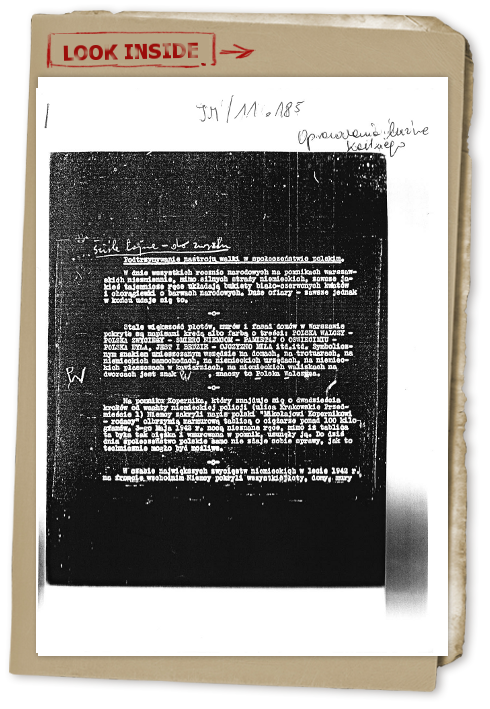| Author's Trip
| The Overall Situation in the Country
| Jewish Questions at Home
| A Brief for the Polish Government
| Sustaining the Spirit of Combat in Polish Society
| An Account of Karski’s Conversation with President Roosevelt

Sustaining the Spirit of Combat in Polish Society
Handwritten: Top Secret, to be returned.
Karski's loose, [verbal] account
On all important national holidays white-and-red flowers and banners appear mysteriously beside Warsaw monuments, despite intense German guarding. These efforts result in many casualties, but they are always somehow successful in the end.
Most of the fences, walls and building facades in Warsaw are covered with writings in chalk or paint saying “FIGHTING POLAND – DEATH TO THE GERMANS- REMEMBER AUSCHWITZ -POLAND HAS BEEN, IS AND WILL BE - DEAR HOMELAND, etc. The “PW” [“Fighting Poland” anchor] symbol marks buildings, sidewalks, German cars, German authorities' headquarters, German coats in coffee shops, German suitcases at train stations.
The Germans covered up a sign on the Copernicus monument that said “For Copernicus – From his Compatriots” with a huge, 100kg (220lb) marble slab. The monument is twenty paces away from a German patrol station on Krakowskie Przedmieście Street. On May 3rd 1942 [Polish Constitution Day], unknown hands took the slab down, despite its weight and the fact that it was embedded in the monument's stone. Till this day the Poles don't understand how this was possible.
During the time of the biggest German victories on the Eastern front, the Germans covered all the fences, houses, walls, streets of Warsaw and the General Government with red posters. They all had titles such as “THE FUHRER SAID...” or “EXCERPTS FROM THE FUHRERS MOST IMPORTANT STATEMENTS,” and pointed to the fact that Hitler had envisioned the current favorable situation. After two days, next to these posters you initially find posters identical in size, color, print, graphics, so that you couldn't tell the difference at first glance. But on these posters, also entitled “The Fuhrer said,” you see excerpts from his statements and speeches compromising his ability to predict the future. For many days the Germans, and even Poles didn't get what it meant. The Poles and Germans would read with awe, horror or joy these posters embarrassing Hitler.
Governor General Frank issued a public notice on thousands of posters calling for the Poles' cooperation. After two days these posters had a narrow strip across them with a red sign saying “REMEMBER AUSCHWITZ, POLE!”
The Germans are trying to demoralize young Poles through movie theaters, theaters and casinos. There are plenty of Polish coffee shops in Warsaw that the Germans attend. Once in a while, at night, stink bombs and tear gas explode during a movie showing or at the casino or at one of the coffee shops.
The Poles' self-defense
In August of 1942, a five-person staff of one of the secret organizations was arrested. They were placed in German custody. After two days, a German car with a German driver arrived, and two “Gestapo” men checked in at the Commander's, presented the appropriate documents, the necessary orders, and demanded to pick up five prisoners to be interrogated at the Gestapo headquarters on Szucha Street. They spoke perfect German, their documents were flawless. The Commander ordered that the prisoners be brought over. Following Gestapo ways, (they always beat the prisoners during their “initial conversation”) the “Gestapo” men attacked the five Poles and severely beat them up. They demanded 5 pairs of handcuffs because they feared that the Poles would escape. They cuffed them, put them in the car. Right after the car sped off, the driver turned to the prisoners and said “Boys, now we have to run, because if they catch you now, not even God will help you!” (I got this account from one of the prisoners … it is entirely correct).
The competent authority issued official state bonds, which will be paid back by the Polish government after the state gains independence. These bonds are being normally circulated among the Poles, despite a death penalty threat in case they are revealed.
There are official Investigative-Accusatory Committees that expose and shame Poles who are misbehaving. There are no abuses; the committees are official in character; the names are printed by the Underground press. (e.g. “engineer Nagorski for rebuilding the Belvedere, the iconic Polish palace, in German fashion...”)
There are official sentences from these official bodies, the death sentence is always performed. The victim can never escape. […]
Tram conductors. Poles have small incomes. The revenues from tram tickets go to the German treasury.
Poles, in great numbers, give their ticket money directly to the conductor, without taking a ticket. This way, the conductor has a larger income, and the German treasury loses money. The Germans introduced a very elaborate system of control, with Gestapo men barging in and checking if everybody has a ticket. If anybody gets caught red-handed, they can be sent to Auschwitz. Special announcements came from the German authorities in this regard, warning the Polish population, and threatening repressions. The “system,” however, still works on a massive scale.The Germans publish the so-called reptile press in Polish. On the orders of the Polish Underground, buying this press is forbidden to test the Polish society's discipline, to protest German authority, to diminish the German treasury's revenues. Each Friday the Germans publish a smaller circulation, because the “system” works quite effectively.
The competent authority of the Polish Underground has issued a series of special “postal stamps.” They feature a skeleton saluting in Nazi fashion. He has a swastika on his shoulder. Poles “purchase” these stamps. Many German letters, newspapers, library books have these stamps on them. Every Pole, within his or her capabilities “distributes” and “uses” these stamps. This is how you gain funds and lower the occupier's morale.
In 1941 the Germans announced in Krakow that by a given date they would be issuing special documents, so-called “Kennkarte” (identity cards) for the Polish and Jewish populations. This order was supposed to prevent falsifying documentation and facilitate identifying fake documents by the Gestapo. Only those who could prove their identity without any doubt could receive these cards. The German Kennkarte were printed and prepared very meticulously. Unfortunately, the Germans weren't able to issue these cards to the Polish population on time. Something unexpected occurred – the Kennkarte started circulating on the ground. The Polish Underground authorities falsified the cards before the Germans even issued them. The owners of these cards had to “wait” until they could officially present them.
On the General Government territories there are approximately 20,000 people who are “delegalized.” They have complete documentation, and based on those papers it is impossible to prove that their last names are fake. In practice, only a provocation or confrontation can reveal who they are.
With relative frequency, important people run away after being arrested. It turns out, often, that when they are in jail, they fall ill with venereal diseases, typhoid and others. The German authorities move them to hospitals, from which they disappear quickly and without a trace.
People working in [underground] organizations, have small, insignificant and completely insufficient salaries. Every once in a while, they receive from the German authorities, by some bizzarre coincidence, special food or clothing rations. They have no idea who is behind this and how it happens. What is even more curious is that these special rations are also given to the “delegalized” people.
